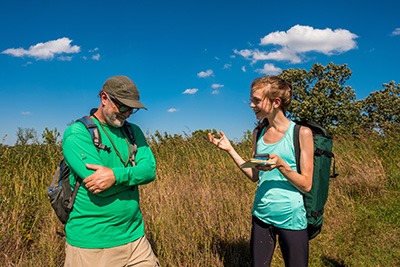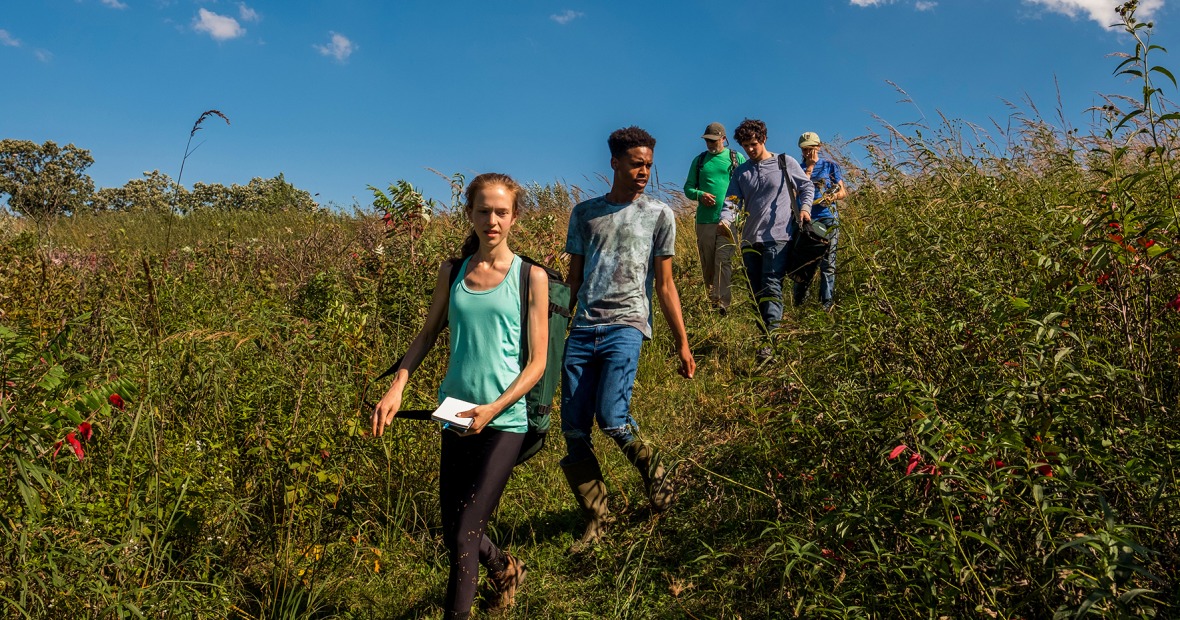Develop Your Environmental Expertise
If you like to get outdoors and do hands-on environmental research, Biology 305: Evolution of the Iowa Flora with Vince Eckhart, Waldo S. Walker Professor of Biology, is a great choice — especially if you’re intrigued by plants and their evolution.
In this course, Eckhart and students investigate Iowa’s plant diversity from three different perspectives: plant diversity and identification, the history of Iowa vegetation, and research about the Iowa flora using the collections of the Grinnell College Herbarium.
For the first half of the class, students spend all scheduled lab time in the field at various sites, including the Conard Environmental Research Area (CERA), Grinnell’s field station, a living ecosystem and laboratory.

“I loved that our labs were going to local pieces of restored prairie,” says Siri Bruhn ’19, a chemistry major. “It felt like a cool, guided nature hike where [Vince] would just be leading us on this adventure through some trail. Then he would send us off to go collect together.” Collecting specimens was part of learning to identify and classify plants accurately.
For one class session during this unit, Eckhart brought in different kinds of fruit, asking students to work together to determine the specific types of fruit, as botanists define them. “It’s not just your apples and your oranges,” Bruhn says. “It’s all of these things that you don't think of. It was the winged samaras that fall from maple trees. I learned that bell peppers were actually berries, and I was like, ‘No!’”
Another surprising thing you’ll learn in this class: Iowa has no plant species that are not also found in other states. What’s distinctive about the Iowa flora is not what plants occur here and nowhere else, but rather that Iowa represents a crossroads where plants of eastern, southern, and western (and a few from northern) regions mix.
Creative and Innovative Discoveries
In fact, expect to be surprised by what you learn in this class because creative discoveries are typical.
During the vegetation history unit, the class studied a piece of Iowa peat. The peat had come from about 15 feet below ground, from the campus construction site for Roberts Theatre back in the 1960s, and been stored for decades in the science building’s basement.
Eckhart saw an opportunity and incorporated the study of the peat into his course.
“The students actually picked it apart and learned some of the techniques for identifying the fossils that are in there,” Eckhart says. “We confirmed that there were larch trees, as in an earlier report by Professor Ben Graham in 1962. And probably spruce trees. There also were fossils of what look like aquatic herbaceous plants, non-woody plants, that are things that you would find now in wetlands in northern Minnesota and Wisconsin, southern Canada.” New carbon dating revealed that the peat is about 27,000 years old.
Eckhart adds, “Iowa was not always predominately prairie.” Prairie arrived about 10,000 years ago. “The students get a sense of the changes that happened in this piece of geography, this piece of land that's politically Iowa, but hasn’t always been that way.”
Research as a Process for Enhancing Education
In the last unit of the class, students mine the College’s herbarium for research projects. In the herbarium “what you've got is a record of locations and people and habitats and insect damage and the time when things flowered and the anatomy of leaves then compared to now,” Eckhart says. “All these things allow you, with some time depth, to study a whole bunch of questions from land history and scientific history, to plant physiology, including changes in flowering time that accompanied the warming of the climate and all sorts of things that you can interrogate this collection to answer.”
Bruhn decided to study physiological differences in different types of grasses, given climate change effects.
She investigated whether particular kinds of species were more or less likely to show strong patterns of historical change in stomata densities. Stomata are the tiny pores on plant leaves through which carbon dioxide, oxygen, and water vapor pass between leaf and atmosphere. Were there fewer stomata in more recently collected specimens, possibly in response to increased carbon dioxide in the atmosphere? Bruhn discovered a trend in that direction, as well as a hint that the magnitude of change depended on the type of photosynthetic system the plants possess.
For Bruhn, the best part of the course is Eckhart himself. “He’s great at leading students to explore without defining their path of exploration. He’s always pushing people to consider other things without really influencing what it is, or where they end up. I like the way he thinks as a scientist and as a teacher.”

